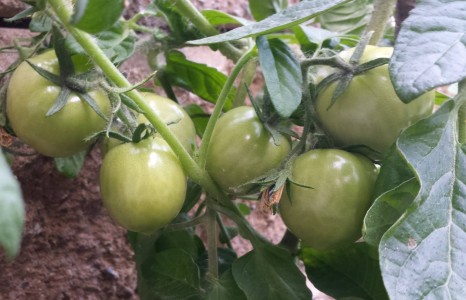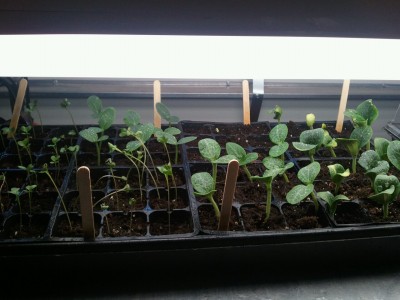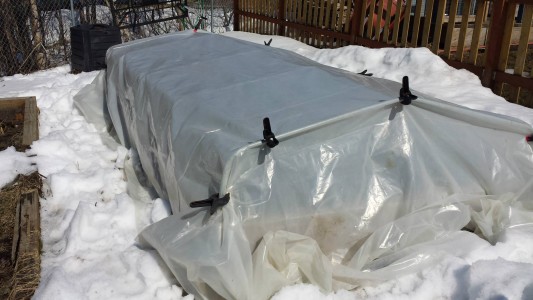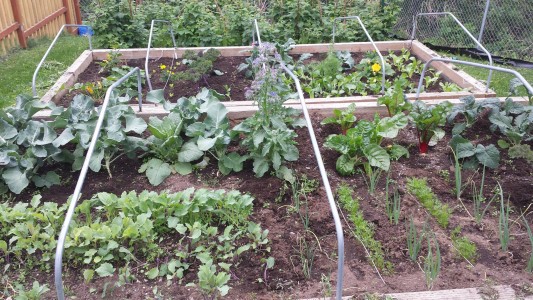My quest for extending the growing season began after my move to Alaska in 2001. Raised in the Midwest I grew up eating tomatoes on the vine, toasted tomato sandwiches, a nd canning bushels of tomatoes. After all, tomatoes are SO easy to grow and very plentiful — right? Well, I see the smile on your knowing faces because after I moved to Alaska it took me nearly a decade to taste my first fresh tomatoes from the vine, and mind you it was not a plentiful bounty. A few years after growing my first red (not green) tomatoes I actually harvested more tomatoes than my family of four could eat, but still not enough yet to can. No, I do not have a greenhouse. This blog post therefore is meant to provide hints for extending the growing season. It is a general guide and can be used for any crop in which you need an extended growing season. I reaped the benefits of extended harvest for many vegetables after I implemented two basic extension techniques.
nd canning bushels of tomatoes. After all, tomatoes are SO easy to grow and very plentiful — right? Well, I see the smile on your knowing faces because after I moved to Alaska it took me nearly a decade to taste my first fresh tomatoes from the vine, and mind you it was not a plentiful bounty. A few years after growing my first red (not green) tomatoes I actually harvested more tomatoes than my family of four could eat, but still not enough yet to can. No, I do not have a greenhouse. This blog post therefore is meant to provide hints for extending the growing season. It is a general guide and can be used for any crop in which you need an extended growing season. I reaped the benefits of extended harvest for many vegetables after I implemented two basic extension techniques.
Star t indoors
t indoors
First, it is essential to start your seeds indoors! As a novice, and not knowing limitations of transplanting, I first started planting all of my seeds indoors. That is certainly not the best approach as some plants are easy to transplant and others very difficult, but it was a great way to learn. A great resource on what to plant and when (in Fairbanks, Alaska) can be found at https://georgesonbg.org/research/vegetables/Seed%20Starting.pdf. There are many internet resources as well with varying advice on time frames for planting and transplanting such as https://georgesonbg.org/research/vegetables/Seed%20Starting.pdf. Start by using someone else’s schedule and then experiment. For example, most schedules say to direct sow kale but I always start it indoors. I am usually harvesting my first crop when everyone else is just seeing seedlings emerge. Always start tomatoes and other “warm” weather crops indoors. Brocolli, brussel sprouts, cabbage and squash flourish when given that little bit of extra time indoors! Flowers take forever to grow (or maybe I always start them too late) — so if planting flowers for baskets give yourself adequate time indoors. Use the preexisting schedules as a place to start but then try anything and everything! After all, the cost of a package of seeds is worth the experiment! Make sure to use good potting soil and grow lights although the details on these would make for another blog post.
Cover your garden beds
To extend the season (on both ends) consider making some sort of hoop system to enclose your garden. My first hoop system was made with PVC pipe. There are many internet resources for making these systems. My current hoop system is made from metal pipes that were bent to allow for the proper height of my raised garden beds. I have extensions to lower or raise the height depending on what I plan to grow that season.
I cover my raised beds with plastic as soon as I can — the snow doesn’t need to be entirely gone.  There is easily a 20-30 degree temperature differential between the interior and exterior temperatures so it doesn’t take long for the soil to thaw. When ready I till the soil, check and adjust the nutrients using compost or bone and blood meal, depending on my needs, and then I start planting. I direct sow seeds in these hoop systems 2 — 3 three weeks before I otherwise could without the system. I generally wait a bit longer for my transplants, just to be
There is easily a 20-30 degree temperature differential between the interior and exterior temperatures so it doesn’t take long for the soil to thaw. When ready I till the soil, check and adjust the nutrients using compost or bone and blood meal, depending on my needs, and then I start planting. I direct sow seeds in these hoop systems 2 — 3 three weeks before I otherwise could without the system. I generally wait a bit longer for my transplants, just to be on the safe side.
on the safe side.
If there is an unseasonably cool summer I keep the plastic on longer or roll up the sides on days when it gets warmer. Removing or rolling up the sides is still important throughout the summer so pollination can occur. However, for the past few warm summers I have taken the cover off completely during the dog days of summer.
I use these same covers at the end of the summer to extend my season by at least a few weeks. Keep a careful watch on the frost schedule and start using the cover intermittently when it gets cooler. Often the snow can fall and I still have vegetables to harvest within my hoops!
So, without too much effort I have been able to extend my outdoor growing season for a minimum of four weeks, sometimes six. This coupled with starting seeds indoors 4 — 8 weeks ahead of time, I have in essence doubled my growing season! 
Yes, tomatoes are now possible, but these techniques also allow me to get so much more life out of my entire garden!